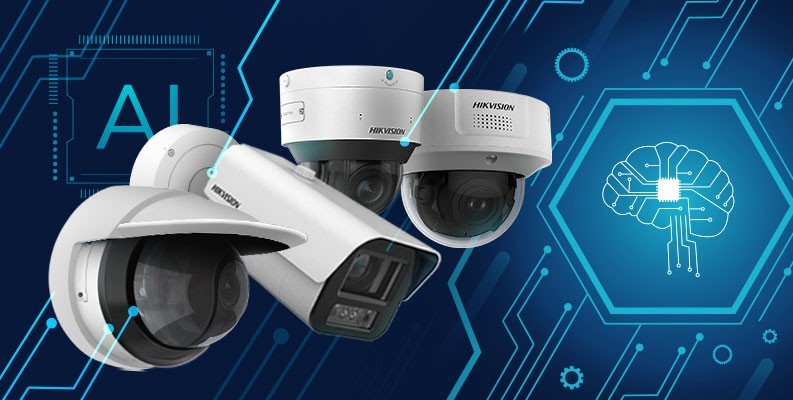The sudden and dramatic rise of AI has transformed how we use and interact with technology. One of the most innovative ways this technology is being used is its increasing integration with security cameras.
In this article, we examine the synergies between artificial intelligence and security cameras. As well as exploring how this marriage is radically changing how we secure our assets, we also discuss the challenges that inevitably follow in the wake of such a disruptive technology and its fusion into surveillance systems.

Table Of Contents 👉
The Evolution of Security Cameras
Before we look at the integration of AI and security cameras, it is worth taking a moment to explore how we reached this point. Security cameras are far from being a new concept and have been used to fight crime in the US since as early as 1968 when Olean, New York installed video cameras in its business district.
However, because the security industry has always been fast to integrate the latest technologies these rudimentary systems bear little resemblance to today’s cameras. Until now, this was a gradual evolution, but the introduction of AI has kicked this trend.
Key steps that led to today’s advanced surveillance systems include:
- Analog to digital transition: The shift from grainy analog video to clearer digital formats revolutionized how footage is captured and stored.
- Connectivity and network cameras: Introduction of IP cameras allowed for remote monitoring and data transmission over the internet.
- Integration of motion sensors: Early forms of smart detection provided alerts for unusual activity, paving the way for more sophisticated AI algorithms.
- Advent of high-definition (HD) video: Improved video quality allowed for better identification and analysis of surveillance footage.
- Cloud-based systems: Cloud-based security cameras removed the necessity for onsite storage and made accessing systems simple from any internet-connected device.
- Incorporation of AI and machine learning: Recent advancements have led to smart cameras capable of facial recognition, anomaly detection, and predictive analytics.
AI’s role in modern cameras is the most significant shift in years, but just how radical is this shift? In the next section, we examine how AI is transforming video surveillance.
Benefits of AI in Security Cameras
The use of words like revolutionary and disruptive are commonly used when describing innovative technologies, often without substance. However, this lack of substance cannot be applied to AI, the integration of which has brought about a genuine revolution in surveillance capabilities.
Among the key benefits that the synergy of AI and security cameras adds to surveillance systems are:
- Enhanced accuracy and reduced false alarms: AI algorithms can differentiate between routine movements and potential threats, significantly reducing false alarms and focusing attention on real security concerns.
- Real-time monitoring and alerts: AI-powered cameras can analyze video footage in real-time, providing immediate alerts about unusual activities or recognized threats, enabling quicker response times.
- Facial recognition and identification: Advanced AI systems can identify individuals, making them invaluable in both security and business intelligence applications, such as tracking customer behavior or identifying repeat offenders.
- Anomaly detection and predictive analytics: AI can detect unusual patterns and predict potential incidents before they occur, transforming cameras from passive recording devices to proactive security tools.
- Efficient data management and search: With AI, searching through hours of footage becomes a task of minutes, as the system can tag and categorize video segments based on content, making retrieval simple and fast. Additionally, utilizing free CCTV calculators can help businesses assess their security needs more effectively, ensuring that the right systems are in place for optimal surveillance.
In the US alone, the security camera market was valued at $35 billion in 2022, this is a massive market to which the use of AI will only add value. However, there are challenges to address as we make the transition.
Challenges of AI in Security Cameras
While the benefits of using AI in security cameras are numerous and substantial, there are distinct hurdles that need to be traversed.
These challenges need to be addressed if AI and security cameras are to prove themselves to be a marriage made in heaven. Key among them are:
- Privacy and ethical concerns: The use of AI, especially facial recognition, raises significant privacy issues, necessitating strict adherence to ethical standards and legal regulations.
- Cybersecurity vulnerabilities: As security systems become smarter, they also become more attractive targets for cyberattacks, requiring advanced cybersecurity measures to protect data integrity.
- Accuracy and reliability: While AI improves efficiency, ensuring the accuracy and reliability of AI algorithms is critical to avoid misidentification and errors in threat detection.
- Adaptability and ongoing learning: AI systems must continuously learn and adapt to new threats and scenarios, requiring ongoing updates and training to stay effective.
There is no such thing as a free lunch and if AI is to be effectively used in security cameras then rising to these challenges must be a priority.
Seeing Into the Future: The Blend of AI and Security Cameras
AI and cloud-based security cameras are a perfect blend of technologies that can deliver increased security, lower costs, and streamlined operations. The technology isn’t yet perfect and components like facial recognition can still make mistakes, so we still need to tread carefully as we move ahead. However, this is the future of video surveillance and it will continue to improve.
We need to balance the undoubted benefits of this synergy while remembering that a secure society also means securing our privacy rights. If implemented properly the synergy of AI and security cameras can successfully walk this tightrope.
